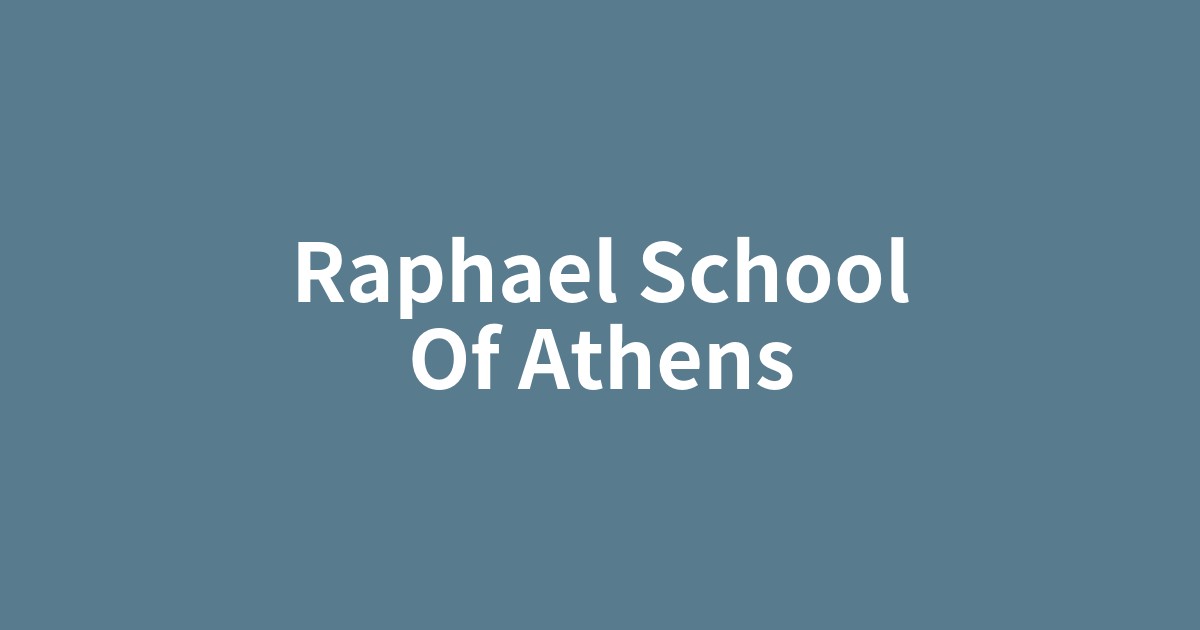このページは、歴史や文化の物語を楽しみながら、その文脈の中で重要な英単語を自然に学ぶための学習コンテンツです。各セクションの下にあるボタンで、いつでも日本語と英語を切り替えることができます。背景知識を日本語で学んだ後、英語の本文を読むことで、より深い理解と語彙力の向上を目指します。

プラトンやアリストテレスをはじめ、古代の賢者たちが一堂に会する壮大な構図。盛期ルネサンスのharmony(調和)と理性の理想を描いた傑作。
この記事で抑えるべきポイント
- ✓『アテナイの学堂』が、盛期ルネサンスの理想である「harmony(調和)」と理性を、古代ギリシャの賢者たちを通して視覚化した傑作であること。
- ✓中央のプラトンとアリストテレスをはじめ、登場人物たちの身振りや配置が、それぞれの哲学思想を象徴的に表現していること。
- ✓ラファエロが用いた一点透視図法(perspective)などの高度な絵画技術が、作品に壮大な奥行きと秩序をもたらしていること。
- ✓この作品がヴァチカン宮殿に描かれた背景には、キリスト教世界と古代の知性を融合させようとした、当時の人文主義的な思潮があったこと。
ラファエロと調和の美 ―『アテナイの学堂』
なぜカトリック教会の総本山であるヴァチカン宮殿に、古代ギリシャの哲学者たちが一堂に会する絵画が描かれたのでしょうか。この壮大な壁画『アテナイの学堂』を手がかりに、盛期ルネサンスという時代が追求した「調和」と「理性」の理想、そして古代の知恵とキリスト教世界が交差する、知の冒険へとあなたを誘います。
Raphael and the Beauty of Harmony - 'The School of Athens'
Why was a painting depicting the great philosophers of ancient Greece gathered together created in the Vatican Palace, the very heart of the Catholic Church? This magnificent fresco, 'The School of Athens,' invites you on an intellectual adventure, exploring the ideals of harmony and reason pursued during the High Renaissance, where ancient wisdom and the Christian world intersected.
ルネサンス精神の結晶 ― 調和(Harmony)と理性の追求
この傑作が生まれたのは、16世紀初頭の「盛期ルネサンス」と呼ばれる時代です。この時代は、古代ギリシャ・ローマ文化の人間中心的な価値観を再評価する、文化運動としての「再生」すなわち`ルネサンス(renaissance)`の頂点にありました。中世の神中心の世界観から、人間の知性や`理性(reason)`を重んじる人文主義(Humanism)へと、大きな価値観の転換が起きていたのです。『アテナイの学堂』は、こうした時代の空気を背景に、多様な学問や思想が対立することなく共存する、理想的な`調和(harmony)`の世界を視覚化した、まさに時代の精神を象徴するモニュメントでした。
The Crystal of the Renaissance Spirit - The Pursuit of Harmony and Reason
This masterpiece was born in the early 16th century, an era known as the High Renaissance. This period was the pinnacle of the cultural movement of 'rebirth,' or the Renaissance, which re-evaluated the human-centered values of ancient Greek and Roman culture. A major shift in values was occurring, moving from the medieval God-centered worldview to Humanism, which emphasized human intellect and reason. Against this backdrop, 'The School of Athens' was a monument symbolizing the spirit of the age, visualizing an ideal world of harmony where diverse studies and ideas could coexist without conflict.
絵画の中心、二人の巨人 ― プラトンとアリストテレスの対話
画面中央に歩みを進める二人の人物に注目してみましょう。左側で天を指さしているのがプラトン、右側で地面に手のひらを向けているのがアリストテレスです。この対照的な身振りは、彼らの`哲学(philosophy)`の根本的な違いを雄弁に物語っています。プラトンは、私たちの目に見える世界を超えた、永遠不変の真実の世界「イデア」こそが本質だと説きました。彼の指し示す天は、その`理想(ideal)`の世界を象徴しています。一方、弟子であるアリストテレスは、現実世界の観察と分析を通じて真理を探究すべきだと考えました。彼の手は、具体的な経験知が根ざす大地を示しているのです。この二人の対話は、その後の西洋思想の大きな二つの潮流の源流となりました。
The Center of the Painting, Two Giants - The Dialogue of Plato and Aristotle
Let's focus on the two figures walking in the center of the painting. On the left, pointing to the heavens, is Plato; on the right, with his palm facing the earth, is Aristotle. This contrasting gesture eloquently speaks to the fundamental difference in their philosophy. Plato argued that the true essence of reality was the 'world of Forms,' an eternal and unchanging realm of truth beyond our visible world. The sky he points to symbolizes this ideal world. In contrast, his student Aristotle believed that truth should be sought through the observation and analysis of the physical world. His hand indicates the earth, where concrete, empirical knowledge is rooted. The dialogue between these two became the source of the two major currents in subsequent Western thought.
空間を支配する技術 ― 遠近法(Perspective)と構図の妙
ラファエロがこの絵画で示した卓越した技術も、作品の魅力を語る上で欠かせません。特に、床に描かれた幾何学模様や、奥へと続く壮大なアーチの連なりは、画面中央の一点(消失点)へと収束するように描かれています。これは`遠近法(perspective)`、中でも一点透視図法と呼ばれる技法で、二次元の壁面に驚くほどの奥行きと秩序ある空間を生み出しました。また、50人以上もの人物は、無秩序に描かれているわけではありません。中央の二人を頂点に、左右対称にリズミカルなグループを形成する巧みな`構図(composition)`によって、画面全体に安定感と調和がもたらされているのです。
The Technique that Dominates Space - The Marvels of Perspective and Composition
Raphael's outstanding technique in this painting is also essential to understanding its appeal. In particular, the geometric patterns on the floor and the series of grand arches extending into the background are drawn to converge at a single point (the vanishing point) in the center of the frame. This is a technique called perspective, specifically one-point perspective, which creates astonishing depth and an ordered space on a two-dimensional wall. Furthermore, the more than 50 figures are not randomly placed. The masterful composition, which arranges them in rhythmic groups symmetrically around the central pair, brings stability and harmony to the entire scene.
古代の賢者たちの饗宴 ― 描かれた人物とその寓意(Allegory)
この絵画には、プラトンとアリストテレス以外にも、古代世界の知の巨人たちが数多く描き込まれています。階段の下では、幾何学の父ユークリッドがコンパスを手に図形を論じ、その対角線上では数学者ピタゴラスが書物に没頭しています。また、前景で一人肘をつき物思いにふける人物は、万物の流転を説いた哲学者ヘラクレイトスです。このように、描かれた人物たちはそれぞれが特定の学問分野や思想を象徴しており、『アテナイの学堂』は単なる群像画ではありません。それは哲学、数学、天文学といった多様な知性が一堂に会する、壮大な`寓意(allegory)`画なのです。
A Banquet of Ancient Sages - The Depicted Figures and their Allegory
Beyond Plato and Aristotle, this painting features many other intellectual giants of the ancient world. On the steps below, Euclid, the father of geometry, discusses a diagram with a compass, while diagonally opposite, the mathematician Pythagoras is engrossed in a book. The brooding figure leaning on his elbow in the foreground is Heraclitus, the philosopher who taught that all things are in a state of flux. As such, each depicted figure symbolizes a specific academic field or idea, making 'The School of Athens' more than just a group portrait. It is a grand allegory, where diverse intellects from philosophy, mathematics, and astronomy gather in one place.
結論
『アテナイの学堂』は、歴史上の人物の肖像画集ではなく、古代の知恵への深い敬意とルネサンスの理想が結晶した、時代精神の記念碑と言えるでしょう。ラファエロが描いた、異なる価値観や思想が対話を通じて共存する「調和」の世界は、複雑化し対立が増す現代を生きる私たちに、多様性を受け入れ、より高次の理解を目指すための重要なヒントを与えてくれるのかもしれません。
Conclusion
'The School of Athens' is not merely a collection of portraits of historical figures, but a monument to the spirit of its age, a crystallization of deep respect for ancient wisdom and the ideals of the Renaissance. The world of harmony that Raphael depicted, where different values and ideas coexist through dialogue, may offer us, living in an increasingly complex and confrontational modern world, an important hint for embracing diversity and aiming for a higher level of understanding.
テーマを理解する重要単語
reason
中世の神中心の世界観から、人間の知性や「理性」を重んじるルネサンスへの転換を象徴する単語です。記事では人文主義の核となる概念として登場します。『アテナイの学堂』がなぜ描かれたのか、その思想的背景を理解する上で不可欠な言葉と言えるでしょう。
文脈での用例:
Humans are distinguished from other animals by their ability to reason.
人間は理性的に思考する能力によって他の動物と区別される。
harmony
『アテナイの学堂』が描く中心テーマが「調和」です。この記事では、多様な思想や学問が対立せずに共存するルネサンスの理想世界を指す言葉として使われています。この単語を理解することで、ラファエロが絵画全体で表現しようとした核心的なメッセージを掴むことができます。
文脈での用例:
The choir sang in perfect harmony.
聖歌隊は完璧なハーモニーで歌った。
monument
『アテナイの学堂』が単なる絵画ではなく、ルネサンスという時代の精神が結晶した「記念碑」であると結論づける、力強い言葉です。歴史上の偉大な功績や出来事を後世に伝えるもの、という意味合いを持ちます。この作品の持つ不朽の価値と歴史的重要性を理解する上で鍵となる単語です。
文脈での用例:
The Lincoln Memorial is a famous monument in Washington D.C.
リンカーン記念堂はワシントンD.C.にある有名な記念建造物です。
composition
50人以上の人物が、無秩序ではなくリズミカルなグループを形成していることを説明する際に使われています。ラファエロがいかにして画面全体に安定感と調和をもたらしたか、その芸術的な「構図」の妙を理解するための鍵となります。美術や音楽、文章など幅広い分野で使われる単語です。
文脈での用例:
The chemical composition of water is two parts hydrogen and one part oxygen.
水の化学組成は水素2、酸素1です。
perspective
ラファエロの卓越した技術を示す言葉です。この記事では絵画に奥行きを与える「遠近法」の意味ですが、一般には「観点」の意味でも頻出します。絵画技法と抽象的な意味の両方を知ることで、この単語の持つ奥行きが理解でき、ラファエロが秩序ある空間と調和の世界観を重ね合わせた意図が読み取れます。
文脈での用例:
Try to see the issue from a different perspective.
その問題を異なる視点から見てみなさい。
ideal
天を指さすプラトンの身振りが象徴する「理想」の世界(イデア)を指す言葉として使われています。現実世界を重視したアリストテレスとの対比を明確にし、彼らの哲学の根本的な違いを理解する上で欠かせません。この絵画が追求した「理想的な調和」というテーマにも繋がる重要な概念です。
文脈での用例:
He is the ideal candidate for the job.
彼はその仕事にとって理想的な候補者だ。
philosophy
絵の中心に描かれたプラトンとアリストテレスの対話は、西洋「哲学」の二大潮流の源流を示しています。この記事では、彼らの身振りが示す根本的な思想の違いを読み解くことが、絵画理解の鍵です。単なる学問名としてでなく、思想の体系を指す言葉として捉えることが重要です。
文脈での用例:
He studied Greek philosophy and its influence on Western thought.
彼はギリシャ哲学と、それが西洋思想に与えた影響を研究した。
intersect
記事冒頭で「古代の知恵とキリスト教世界が交差する」と、ルネサンスの本質を表現するために使われています。異なる文化や思想が出会い、影響を与え合うという、この時代のダイナミズムを的確に捉えた動詞です。この言葉は、『アテナイの学堂』が持つ複合的な文化的背景を理解する手助けとなります。
文脈での用例:
The story explores where the lives of the rich and the poor intersect.
その物語は、富裕層と貧困層の人生が交差する場所を探求している。
renaissance
記事全体の時代背景である「再生」を意味する言葉です。古代ギリシャ・ローマ文化の人間中心的な価値観を再評価したこの文化運動の頂点に『アテナイの学堂』が位置づけられています。この単語は、この記事の歴史的文脈を理解するための出発点であり、西洋史の大きな転換点を示す言葉です。
文脈での用例:
Leonardo da Vinci was a great artist of the Italian Renaissance.
レオナルド・ダ・ヴィンチはイタリア・ルネサンスの偉大な芸術家でした。
converge
絵画の空間を支配する技術、遠近法を説明する箇所で登場します。床の模様やアーチが画面中央の一点(消失点)へと「収束する」様子を表す動詞です。これにより画面に秩序と奥行きが生まれることを理解できます。物理的な集中だけでなく、意見などが一つにまとまる意味でも使われる重要な単語です。
文脈での用例:
Thousands of supporters converged on the capital for the rally.
何千人もの支持者が集会のために首都に集まった。
allegory
この絵が単なる群像画ではなく、哲学や数学といった知性が一堂に会する壮大な「寓意画」であることを示す最重要単語です。描かれた一人ひとりが特定の学問や思想を象徴しているという、絵画の深い読み解きを可能にします。この言葉を知ることで、作品の知的側面を深く味わうことができます。
文脈での用例:
George Orwell's 'Animal Farm' is a famous political allegory.
ジョージ・オーウェルの『動物農場』は有名な政治的寓話です。
eloquently
プラトンとアリストテレスの対照的な身振りが、いかに彼らの哲学の違いを「雄弁に」物語っているかを表現するのに使われています。言葉を発さずとも、視覚的な要素が豊かな意味を伝える様子を描写するのに最適な副詞です。絵画鑑賞における深い洞察を促す、表現力豊かな単語と言えるでしょう。
文脈での用例:
He spoke eloquently about the need for environmental protection.
彼は環境保護の必要性について雄弁に語った。